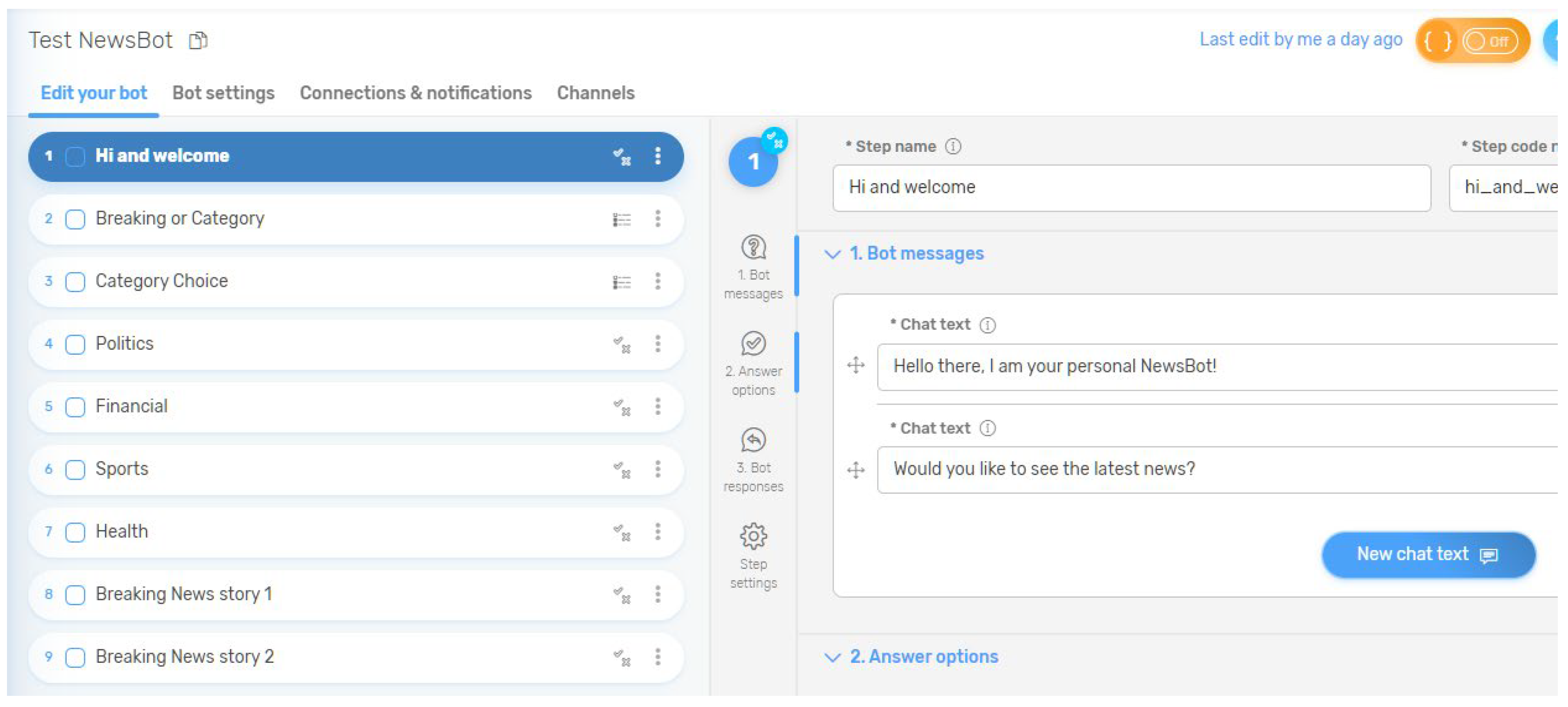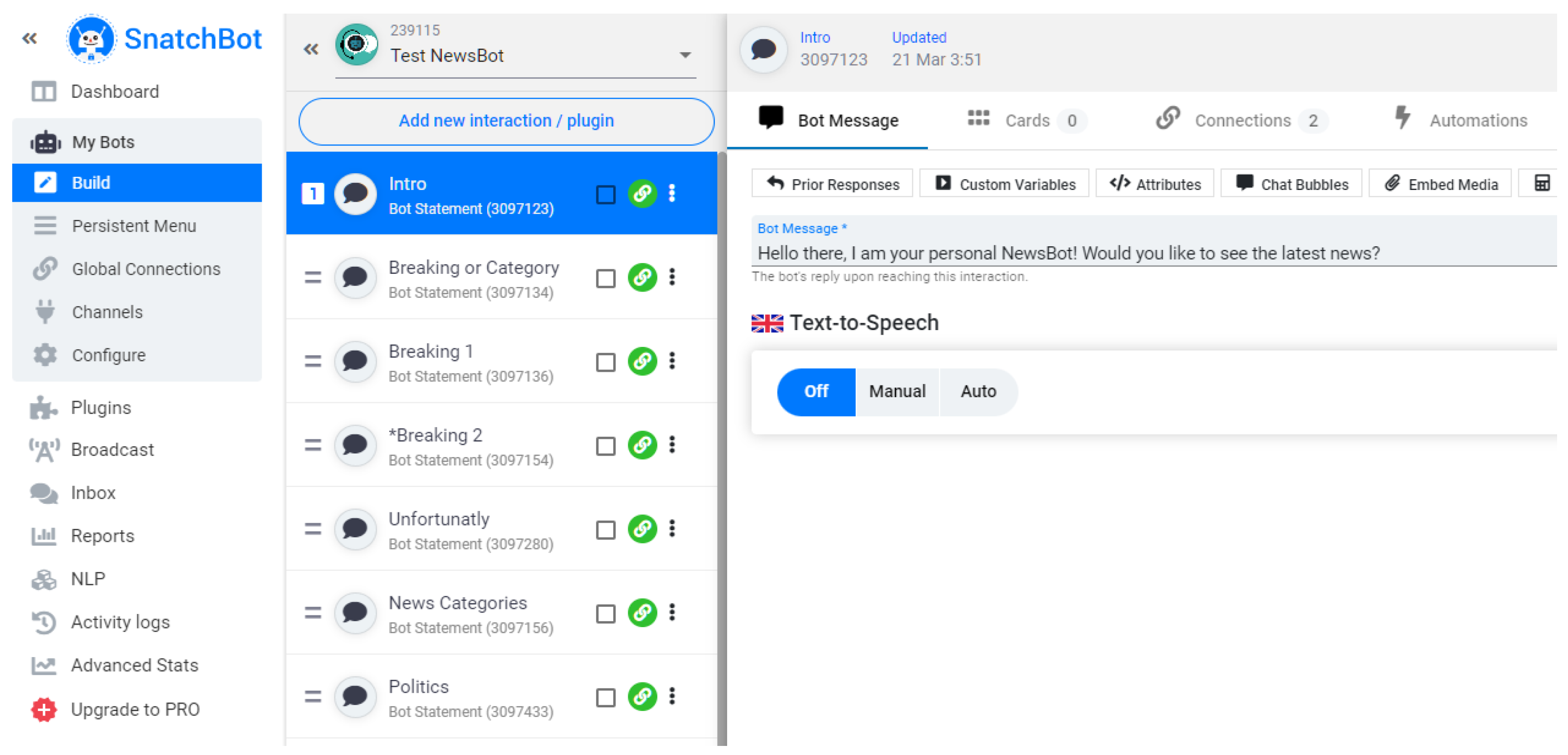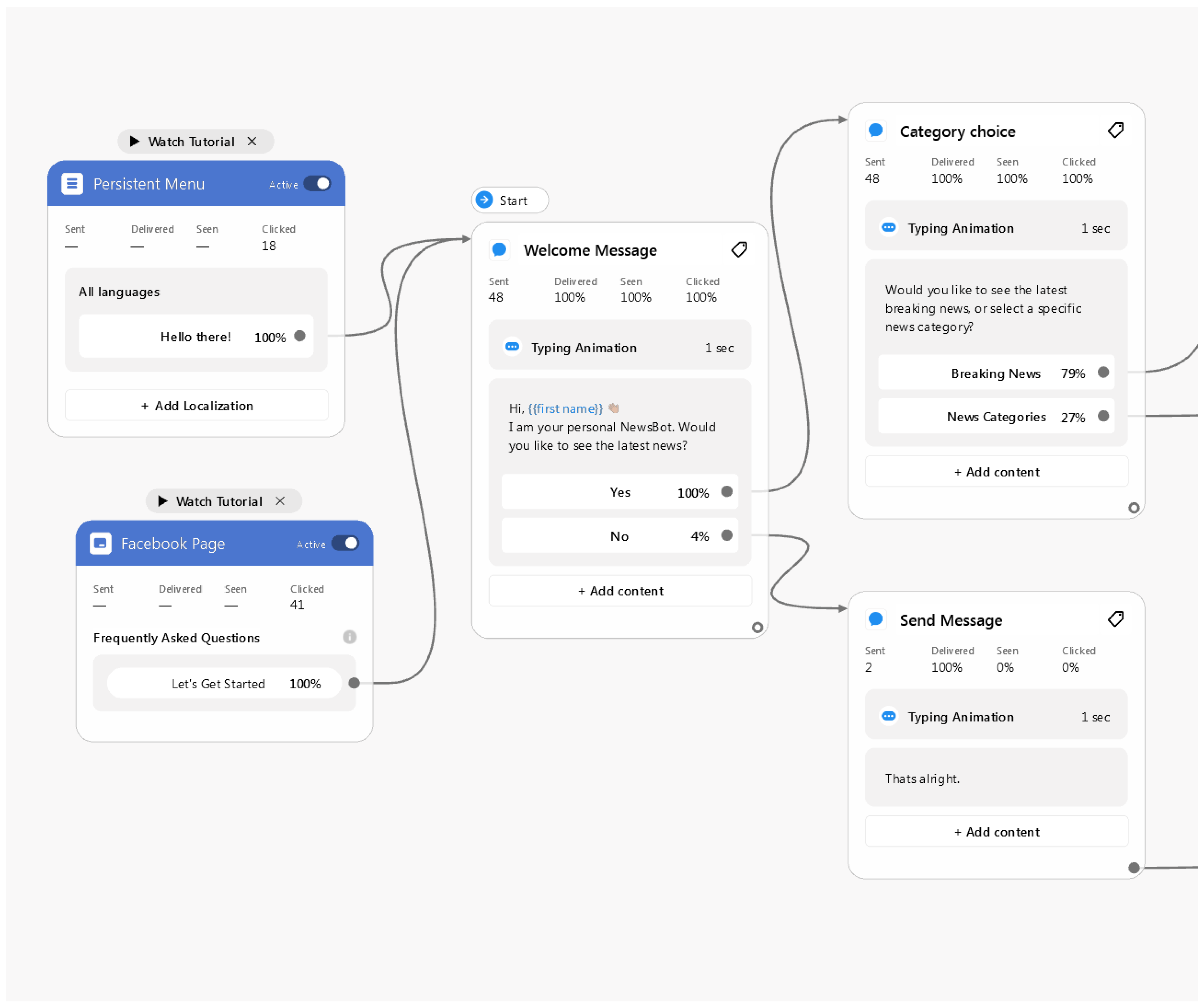Integrating Chatbot Media Automations in Professional Journalism: An Evaluation Framework
Abstract
1. Introduction
2. Related Work
2.1. Chatbot Categories and Architecture
2.2. Chatbots and Media Automations in Journalism
2.3. Interactivity in Chatbot Design
3. Integrating Chatbots in Professional Journalism
3.1. A Framework for Journalism-Oriented Chatbots
Use Case Scenario
- Automatically;
- Systematically;
- Interactively.
3.2. Methodology for the Evaluation of Chatbot Platforms for Journalism
3.2.1. Chatbot Creation Platforms
Quriobot
SnatchBot
Chatfuel
3.2.2. Heuristic Metric-Based Evaluation of Creation Interactivity
- The complexity of choice available: a metric of the provided features and the ability to customize certain parameters;
- Effort users must exert: a measurement of how user-friendly the platform is, where the higher the score, the less effort is required for its proper use;
- Responsiveness to the user: the extent of the ability of the end-user (audience) to contact the creator of the chatbot (journalist) through the interface;
- Facilitation of interpersonal communication: the chatbot’s ability to act as a medium through which users can communicate with each other;
- Ease of adding information: a user’s ability to contribute to the product by providing their own information and/or feedback;
- Monitor system use: the ability of the creator to track and measure certain parameters regarding their chatbot, such as user statistics and behaviors.
3.2.3. Chatbot Creation Workshop and Back-End Usability Evaluation
3.2.4. Front-End Usability Evaluation
4. Results and Discussion
4.1. Metric-Based Evaluation Results
4.2. Back-End Workshop and Evaluation Results
4.3. Front-End Evaluation Results
5. Conclusions and Further Work
Author Contributions
Funding
Institutional Review Board Statement
Informed Consent Statement
Data Availability Statement
Conflicts of Interest
References
- Spyridou, L.-P.; Matsiola, M.; Veglis, A.; Kalliris, G.; Dimoulas, C. Journalism in a State of Flux: Journalists as Agents of Technology Innovation and Emerging News Practices. Int. Commun. Gaz. 2013, 75, 76–98. [Google Scholar] [CrossRef]
- Pavlik, J. The Impact of Technology on Journalism. Journal. Stud. 2000, 1, 229–237. [Google Scholar] [CrossRef]
- Kotenidis, E.; Veglis, A. Algorithmic Journalism—Current Applications and Future Perspectives. Journal. Media 2021, 2, 244–257. [Google Scholar] [CrossRef]
- Valtolina, S.; Barricelli, B.R. Chatbots and Conversational Interfaces: Three Domains of Use. In Proceedings of the Fifth International Workshop on Cultures of Participation in the Digital Age: Design Trade-offs for an Inclusive Society co-located with the International Conference on Advanced Visual Interfaces, Castiglione della Pescaia, Italy, 29 May 2018; pp. 62–70. [Google Scholar]
- Rogers, E.M. Diffusion of Innovations, 3rd ed.; Free Press: New York, NY, USA, 1983; ISBN 978-0-02-926650-2. [Google Scholar]
- Chung, D.S. Profits and Perils: Online News Producers’ Perceptions of Interactivity and Uses of Interactive Features. Convergence 2007, 13, 43–61. [Google Scholar] [CrossRef]
- Jain, M.; Kumar, P.; Kota, R.; Patel, S.N. Evaluating and Informing the Design of Chatbots. In Proceedings of the 2018 Designing Interactive Systems Conference, Hong Kong, China, 8 June 2018; pp. 895–906. [Google Scholar]
- Dale, R. The Return of the Chatbots. Nat. Lang. Eng. 2016, 22, 811–817. [Google Scholar] [CrossRef]
- Ritter, A.; Cherry, C.; Dolan, W.B. Data-Driven Response Generation in Social Media. In Proceedings of the 2011 Conference on Empirical Methods in Natural Language Processing, Edinburgh, UK, 27–31 July 2011; pp. 583–593. [Google Scholar]
- Wu, Y.; Wu, W.; Xing, C.; Zhou, M.; Li, Z. Sequential Matching Network: A New Architecture for Multi-Turn Response Selection in Retrieval-Based Chatbots. arXiv 2017, arXiv:1612.01627. [Google Scholar]
- Veglis, A.; Maniou, T.A. Chatbots on the Rise: A New Narrative in Journalism. Stud. Media Commun. 2019, 7, 1–6. [Google Scholar] [CrossRef]
- Li, X.; Mou, L.; Yan, R.; Zhang, M. StalemateBreaker: A Proactive Content-Introducing Approach to Automatic Human-Computer Conversation. arXiv 2016, arXiv:1604.04358. [Google Scholar]
- Shang, L.; Lu, Z.; Li, H. Neural Responding Machine for Short-Text Conversation. In Proceedings of the 53rd Annual Meeting of the Association for Computational Linguistics and the 7th International Joint Conference on Natural Language Processing; Association for Computational Linguistics, Beijing, China, 26–31 July 2015; Volume 1, pp. 1577–1586. [Google Scholar]
- Kim, J.; Lee, H.-G.; Kim, H.; Lee, Y.; Kim, Y.-G. Two-Step Training and Mixed Encoding-Decoding for Implementing a Generative Chatbot with a Small Dialogue Corpus. In Proceedings of the Workshop on Intelligent Interactive Systems and Language Generation (2IS&NLG), Tilburg, The Netherlands, 5 November 2018; pp. 31–35. [Google Scholar]
- Mondal, A.; Dey, M.; Das, D.; Nagpal, S.; Garda, K. Chatbot: An Automated Conversation System for the Educational Domain. In Proceedings of the 2018 International Joint Symposium on Artificial Intelligence and Natural Language Processing (iSAI-NLP), Pattaya, Thailand, 15–17 November 2018; pp. 1–5. [Google Scholar]
- Janarthanam, S. Hands-on Chatbots and Conversational UI Development: Build Chatbots and Voice User Interfaces with Chatfuel, Dialogflow, Microsoft Bot Framework, Twilio, and Alexa Skills; Packt Publishing Ltd.: Birmingham, UK, 2017. [Google Scholar]
- Weizenbaum, J. ELIZA—A Computer Program for the Study of Natural Language Communication between Man and Machine. Commun. ACM 1966, 9, 36–45. [Google Scholar] [CrossRef]
- Shum, H.-Y.; He, X.; Li, D. From Eliza to XiaoIce: Challenges and Opportunities with Social Chatbots. arXiv 2018, arXiv:1801.01957. 19, 10–26. [Google Scholar] [CrossRef]
- Anderson, C.W. Towards a Sociology of Computational and Algorithmic Journalism. New Media Soc. 2013, 15, 1005–1021. [Google Scholar] [CrossRef]
- Salzwedel, M. The Rise of Robojournalism: African Trends. Rhodes Journal. Rev. 2014, 2014, 85–87. [Google Scholar]
- Carlson, M. Automating Judgment? Algorithmic Judgment, News Knowledge, and Journalistic Professionalism. New Media Soc. 2018, 20, 1755–1772. [Google Scholar] [CrossRef]
- Lokot, T.; Diakopoulos, N. News Bots: Automating News and Information Dissemination on Twitter. Digit. Journal. 2016, 4, 682–699. [Google Scholar] [CrossRef]
- Jones, B.; Jones, R. Public Service Chatbots: Automating Conversation with BBC News. Digit. Journal. 2019, 7, 1032–1053. [Google Scholar] [CrossRef]
- Diakopoulos, N. Automating the News; Harvard University Press: Cambridge, MA, USA, 2019. [Google Scholar]
- Veglis, A.; Dimoulas, C.; Kalliris, G. Towards Intelligent Cross-Media Publishing: Media Practices and Technology Convergence Perspectives. In Media Convergence Handbook—Vol. 1: Journalism, Broadcasting, and Social Media Aspects of Convergence; Lugmayr, A., Dal Zotto, C., Eds.; Media Business and Innovation; Springer: Berlin/Heidelberg, Germany, 2016; pp. 131–150. ISBN 978-3-642-54484-2. [Google Scholar]
- Thurman, N. Computational Journalism. In The Handbook of Journalism Studies; Wahl-Jorgensen, K., Hanitzsch, T., Eds.; Routledge: New York, NY, USA, 2018; pp. 180–195. ISBN 9781315167497. [Google Scholar]
- Graefe, A. Guide to Automated Journalism. Available online: https://academiccommons.columbia.edu/doi/10.7916/D80G3XDJ (accessed on 28 September 2022).
- Katsaounidou, A.; Dimoulas, C.; Veglis, A. Cross-Media Authentication and Verification: Emerging Research and Opportunities; IGI Global: Hershey, PA, USA, 2018; ISBN 978-1-5225-5593-3. [Google Scholar]
- Sidiropoulos, E.; Vryzas, N.; Vrysis, L.; Avraam, E.; Dimoulas, C. Growing Media Skills and Know-How In Situ: Technology-Enhanced Practices and Collaborative Support in Mobile News-Reporting. Educ. Sci. 2019, 9, 173. [Google Scholar] [CrossRef]
- Clerwall, C. Enter the Robot Journalist: Users’ Perceptions of Automated Content. Journal. Pract. 2014, 8, 519–531. [Google Scholar] [CrossRef]
- Carlson, M. The Robotic Reporter. Digit. Journal. 2015, 3, 416–431. [Google Scholar] [CrossRef]
- Matsiola, M.; Dimoulas, C.; Kalliris, G.; Veglis, A.A. Augmenting User Interaction Experience through Embedded Multimodal Media Agents in Social Networks. Available online: https://www.igi-global.com/chapter/augmenting-user-interaction-experience-through-embedded-multimodal-media-agents-in-social-networks/www.igi-global.com/chapter/augmenting-user-interaction-experience-through-embedded-multimodal-media-agents-in-social-networks/198632 (accessed on 12 June 2022).
- Veglis, A.; Maniou, T.A. Embedding a Chatbot in a News Article: Design and Implementation. In Proceedings of the 23rd Pan-Hellenic Conference on Informatics, Nicosia, Cyprus, 28–30 November 2019; pp. 169–172. [Google Scholar]
- Veglis, A.; Kotenidis, E. Employing Chatbots for Data Collection in Participatory Journalism and Crisis Situations. J. Appl. Journal. Media Stud. 2020, 11, 309–332. [Google Scholar] [CrossRef]
- Maniou, T.A.; Veglis, A. Employing a Chatbot for News Dissemination during Crisis: Design, Implementation and Evaluation. Future Internet 2020, 12, 109. [Google Scholar] [CrossRef]
- Verma, P.; Saxena, A.; Sharma, A.; Thies, B.; Mehta, D. A WhatsApp Bot for Citizen Journalism in Rural India. In ACM SIGCAS Conference on Computing and Sustainable Societies; Association for Computing Machinery: New York, NY, USA, 2021; pp. 423–427. [Google Scholar]
- Ford, H.; Hutchinson, J. Newsbots That Mediate Journalist and Audience Relationships. Digit. Journal. 2019, 7, 1013–1031. [Google Scholar] [CrossRef]
- Shin, D.; Al-Imamy, S.; Hwang, Y. Cross-Cultural Differences in Information Processing of Chatbot Journalism: Chatbot News Service as a Cultural Artifact. Cross Cult. Strateg. Manag. 2022, 29, 618–638. [Google Scholar] [CrossRef]
- Steuer, J. Defining Virtual Reality: Dimensions Determining Telepresence. J. Commun. 1992, 42, 73–93. [Google Scholar] [CrossRef]
- Liu, Y.; Shrum, L.J. What Is Interactivity and Is It Always Such a Good Thing? Implications of Definition, Person, and Situation for the Influence of Interactivity on Advertising Effectiveness. J. Advert. 2002, 31, 53–64. [Google Scholar] [CrossRef]
- Ksiazek, T.B.; Peer, L.; Lessard, K. User Engagement with Online News: Conceptualizing Interactivity and Exploring the Relationship between Online News Videos and User Comments. New Media Soc. 2016, 18, 502–520. [Google Scholar] [CrossRef]
- Boczkowski, P.J. Digitizing the News: Innovation in Online Newspapers; MIT Press: Cambridge, MA, USA, 2005. [Google Scholar]
- Deuze, M. What Is Journalism? Professional Identity and Ideology of Journalists Reconsidered. Journalism 2005, 6, 442–464. [Google Scholar] [CrossRef]
- Chung, D.S.; Yoo, C.Y. Audience Motivations for Using Interactive Features: Distinguishing Use of Different Types of Interactivity on an Online Newspaper. Mass Commun. Soc. 2008, 11, 375–397. [Google Scholar] [CrossRef]
- Veenstra, M.; Wouters, N.; Kanis, M.; Brandenburg, S.; teRaa, K.; Wigger, B.; Moere, A.V. Should Public Displays Be Interactive? Evaluating the Impact of Interactivity on Audience Engagement. In Proceedings of the 4th International Symposium on Pervasive Displays, Saarbrücken, Germany, 10 June 2015; pp. 15–21. [Google Scholar]
- Brissette-Gendron, R.; Léger, P.-M.; Courtemanche, F.; Chen, S.L.; Ouhnana, M.; Sénécal, S. The Response to Impactful Interactivity on Spectators’ Engagement in a Digital Game. Multimodal Technol. Interact. 2020, 4, 89. [Google Scholar] [CrossRef]
- Jensen, J.F. ‘Interactivity’: Tracking a New Concept in Media and Communication Studies. Nord. Rev. 1998, 19, 185–204. [Google Scholar]
- Asbjørn, F.; Petter, B.B.; Tom, F.; Effie, L.L.; Manfred, T.; Ewa, A.L. Chatbots for Social Good. In Extended Abstracts of the 2018 CHI Conference on Human Factors in Computing Systems; Association for Computing Machinery: New York, NY, USA, 2018. [Google Scholar]
- Heeter, C. Implications of Interactivity for Communication Research. In Media Use in the Information Age: Emerging Patterns of Adoption and Consumer Use; Lawrence Erlbaum Associates: Hillsdale, NJ, USA, 1989; pp. 217–235. [Google Scholar]
- Chin, J.P.; Diehl, V.A.; Norman, K.L. Development of an Instrument Measuring User Satisfaction of the Human-Computer Interface. In Proceedings of the SIGCHI Conference on Human Factors in Computing Systems, Association for Computing Machinery, New York, NY, USA, 1 May 1988; pp. 213–218. [Google Scholar]
- Davis, F.D. Perceived Usefulness, Perceived Ease of Use, and User Acceptance of Information Technology. MIS Q. 1989, 13, 319–340. [Google Scholar] [CrossRef]
- McHugh, M.L. Interrater Reliability: The Kappa Statistic. Biochem. Med. 2012, 22, 276–282. [Google Scholar] [CrossRef]






| Interactivity Parameters | Quriobot | SnatchBot | Chatfuel |
|---|---|---|---|
| Complexity of choice available | 3 | 5 | 5 |
| Effort users must exert | 4 | 3 | 4 |
| Responsiveness to the user | 4 | 4 | 5 |
| Facilitation of interpersonal communication | 1 | 2 | 2 |
| Ease of adding information | 4 | 4 | 4 |
| Monitor system use | 5 | 2 | 3 |
| Total: | 21 | 20 | 23 |
Publisher’s Note: MDPI stays neutral with regard to jurisdictional claims in published maps and institutional affiliations. |
© 2022 by the authors. Licensee MDPI, Basel, Switzerland. This article is an open access article distributed under the terms and conditions of the Creative Commons Attribution (CC BY) license (https://creativecommons.org/licenses/by/4.0/).
Share and Cite
Kotenidis, E.; Vryzas, N.; Veglis, A.; Dimoulas, C. Integrating Chatbot Media Automations in Professional Journalism: An Evaluation Framework. Future Internet 2022, 14, 343. https://doi.org/10.3390/fi14110343
Kotenidis E, Vryzas N, Veglis A, Dimoulas C. Integrating Chatbot Media Automations in Professional Journalism: An Evaluation Framework. Future Internet. 2022; 14(11):343. https://doi.org/10.3390/fi14110343
Chicago/Turabian StyleKotenidis, Efthimis, Nikolaos Vryzas, Andreas Veglis, and Charalampos Dimoulas. 2022. "Integrating Chatbot Media Automations in Professional Journalism: An Evaluation Framework" Future Internet 14, no. 11: 343. https://doi.org/10.3390/fi14110343
APA StyleKotenidis, E., Vryzas, N., Veglis, A., & Dimoulas, C. (2022). Integrating Chatbot Media Automations in Professional Journalism: An Evaluation Framework. Future Internet, 14(11), 343. https://doi.org/10.3390/fi14110343









